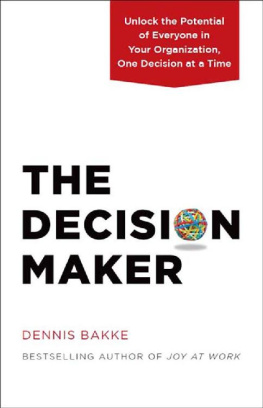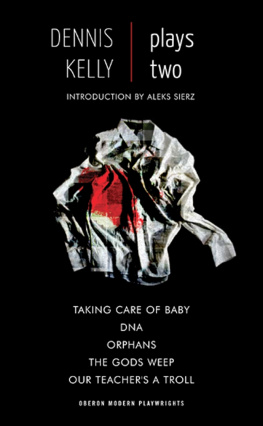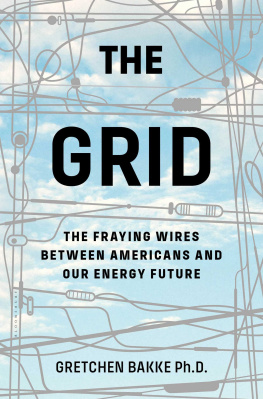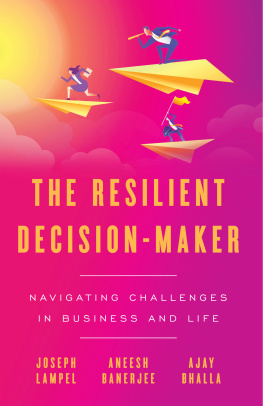Also by Dennis Bakke
Joy at Work
THE DECISION MAKER. Copyright 2013 by Dennis W. Bakke.
All rights reserved. Printed in the United States of America. No part of this book may be used or reproduced in any manner whatsoever without written permission except in the case of brief quotations embodied in critical articles or reviews. Requests for permission should be addressed to:
Pear Press
P.O. Box 70525
Seattle, WA 98127-0525
U.S.A.
This book may be purchased for educational, business, or sales promotional use. For information, please visit www.pearpress.com.
FIRST EDITION
Library of Congress Cataloging-In-Publication has been applied for.
ISBN-13: 978-0-9832633-4-0
To Eileen Harvey Bakke,
the love and joy of my life,
and the best friend
anyone could ever have
Contents
Nothing tells you more about an organization than the way it makes decisions.
Do leaders trust team members? Do the people closest to the action get to make the call? Do team members have real responsibility and real control? All of these questions can be answered by one other one: who gets to make the decisions?
And nothing affects an organization more than the decisions the people in it make.
Great business minds know this. In fact, decision-making is at the heart of all business education. Nearly a hundred years after the case-study method was invented at Harvard, its still the foundation of the worlds best business programs. Why? Because the case-study method puts top business students in the role of decision-maker. Over the course of a Harvard MBA, students will make decisions on more than 500 cases. Decision-making is simply the best way in the world to develop people. And real-life decisions are more importantand more funthan any case study.
But outside of business school, few business leaders tap into the value created by putting important decisions in the hands of their people. Instead, team players are taught to do what theyre told. This takes the fun out of work, and it robs people of the chance to contribute in a meaningful way. Or, organizations will use a participatory style of decision-making in which recommendations are given to the boss, who then makes the final decision. This approach also fails to fully realize the value of the people in the organization. What I am talking about is quite different. In a decision-maker company:
the leader chooses someone to make a key decision
the decision-maker seeks advice (including from the leader) to gather information
the final decision is made not by the leader, but by the chosen decision-maker.
At AES, an energy company with 27,000 people in 27 countries, and at Imagine Schools, one of the countrys largest non-profit charter school networks, I have had the good fortune to give thousands of people the freedom and responsibility to make decisions that matter. The idea is simple: treat people like people, not machines. When leaders put control into the hands of their people, at all levels, they unlock incalculable potential.
The Decision Maker is a fable, loosely based on my own story, that shows how the ideas that transformed AES and Imagine Schools can transform any organization. The events are fiction, but the passion, purpose, moral questions, and common sense are rooted in decades of my own experience. These ideas can affect the bottom line: cutting-edge research indicates that a decision-maker culture improves financial performance. But its not just about the numbers. Its about people: what makes them tick, and what they can achieve when theyre given real responsibility and real freedom.
One other thing: The Decision Maker is founded on the idea that all of us can make good decisions. So this story is not just for people who currently lead organizations. Its for managers at any level who want to unlock the full potential of the people around them.
No matter where you stand in your organization, change can start with you.
1.
How Bad Is It?
Tom Anderson could see the smoke rising from the manufacturing floor long before he reached the site of the explosion. But even the clouds of steam that belched from the broken machine couldnt prepare him for what he saw when he got there.
The machine wasnt just broken. It seemed to have been obliterated. Through the rolling mist, he could make out a gigantic hole flanked by twisted metal. Shards of glass crunched under his feet.
His partner, Jim Travers, was there already. He looked up as Tom approached.
How bad is it? Tom asked.
Jim shook his head. This ones a total loss, he said. Were insured against that. But were not insured against this.
Tom followed his gaze. Almost miraculously, none of the equipment nearby had been damaged in the explosion. But none of it was working. And neither were their people, who stood in clusters in the aisles, talking amongst themselves.
Columns of numbers began to run through Toms mind. He and Jim had taken over the medical device company only two weeks ago. Theyd sunk everything they had into it. Helen Harris, one of the savviest private-equity investors in their field, had financed the rest, based on Tom and Jims successful track record as managers at a similar operationone where theyd had no ownership at all. Their business plan was aggressive but lean. Tom knew it couldnt withstand a shutdown for long.
Jim sighed. Well, at least no one got hurt.
A shock went through Tom. Hed been so worried about the broken machinery that their peoples safety hadnt even crossed his mind. But despite his relief, he had trouble believing no one had been injured.
Are you kidding? he said, gesturing at the hunks of machinery beyond the steam. If metal couldnt withstand the blast, what chance would a person have had? What was he wearing, body armor?
Jim shook his head. He wasnt here.
Toms heart sank. He and Jim had known MedTec had some problems with morale when they took it over. In fact, theyd seen those problems as an opportunity. The staff and product were both strong; they just werent being used to their fullest potential. Once Tom and Jim came in with their superior management techniques, theyd see higher productivity from the same people. At least thats how the theory went. Their business plan involved changes they hoped would put them in the running for some regional best employer awards. Theyd already put a pair of vintage pinball machines in the employee lounge, installed a micro kitchen, and started providing healthy snack foods free of charge. But it looked like they had a problem here that went deeper than games and snacks could solve.
Why not? Tom asked. Where was he?
Doing what he was told, Jim said. He caught the indicators right away. He knew something was wrong. So he went to get his shift supervisor.
Thank God he wasnt there, Tom said.
Yep, Jim said.
He didnt know how to shut it down on his own? Tom asked.
Oh, no, Jim said. He probably knew better than anyone in the plant. He does it at the end of every shift. But he wasnt authorized. Only the manager could shut it down mid-shift.
And in the meantime, the machine blew.
Jim nodded.
Tom let out a long breath. Thats crazy, he said.
Youre telling me, Jim said.
Tom glanced around at the clusters of workers in the aisles. One man glanced back at him and then quickly averted his eyes, as if he was worried any contact with the boss might lead to trouble. Tom recognized the look. Hed given it to countless bosses himself.










